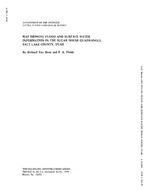
Map showing flood and surface water information in the Sugar House quadrangle, Salt Lake County, Utah
Links
- Plate: Map I-766-N (6.49 MB pdf)
- Cover: Folio Cover (29 KB pdf)
- Download citation as: RIS | Dublin Core
Abstract
In the past man has built on land that might be covered by floodwaters, with little consideration of the consequences. The result has been disastrous to those in the path of floodwaters and has cost the loss of thousands of lives and untold billions of dollars in property damage in the United States. Salt Lake County, of which the Sugar House quadrangle is a part, has had many floods in the past and can be expected to have more in the future. Construction has taken place in filled or dried-up marshes and lakes, in spring areas, and even in stream channels. Lack of prior knowledge of these and other forms of surface water (water at the surface of the ground) can increase construction and maintenance costs significantly.
The map shows the area that probably will be covered by floods at least once in every 100 years on the long-term average (unit IRF, intermediate regional flood), the area that probably will be covered by floods from the worst possible combination of very wet weather and high streamflow reasonably expected of the area (unit SPF, standard project flood), the mapped extent of streamflow by channel shifting or flooding in the past 5,000 years (unit fa), and the probable maximum extent of damaging flash floods and mudflows from small valleys in the Wasatch Range. The map also shows the location of water at the surface of the ground: lakes, streams, springs, weep holes, canals, and reservoirs. Lakes and marshes that existed within the past 100 years, but now are drained, filled, or dried up, are also shown.
The following examples show that the presence of water can be desirable or undesirable, depending on how the water occurs. Floods, the most spectacular form of surface water, may result in great property damage and loss of life. Lakes normally are beneficial, in that they may support plant growth and provide habitats for fish and other wildlife, provide water for livestock, and can be used for recreation. Springs may or may not be desirable: they may provide a source of water for domestic or stock use but are undesirable if they appear in a foundation excavation for a building. Thus, the location of areas that may be affected by floods and other surface water is important to people concerned with land-use planning, zoning, and legislation, and with the environment in which we must live.
Study Area
| Publication type | Report |
|---|---|
| Publication Subtype | USGS Numbered Series |
| Title | Map showing flood and surface water information in the Sugar House quadrangle, Salt Lake County, Utah |
| Series title | IMAP |
| Series number | 766 |
| Chapter | N |
| DOI | 10.3133/i766N |
| Year Published | 1974 |
| Language | English |
| Publisher | U.S. Geological Survey |
| Publisher location | Reston, VA |
| Contributing office(s) | Utah Water Science Center |
| Description | Map: 34.24 x 27.76 inches; Cover: 9.20 x 11.82 inches |
| Country | United States |
| State | Utah |
| County | Salt Lake County |
| Other Geospatial | Sugar House quadrangle |
| Scale | 24000 |

